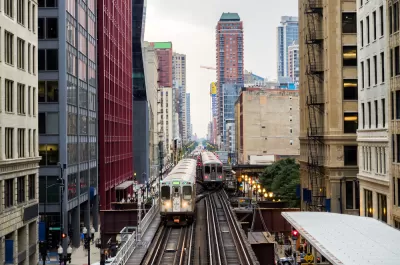A new scorecard from the Chicago Transit Authority will update the public on the agency’s progress on key issues like service delivery, frequency, and infrastructure improvements.

A new scorecard from the Chicago Transit Authority seeks to provide more effective communication to the public about the agency’s progress in achieving the COVID recovery goals set by the Meeting the Moment action plan. As John Greenfield explains in Streetsblog Chicago, “Released in August, the document set targets for providing reliable service, reducing crime, better cleaning protocols, rolling out new amenities, better customer engagement, and more complete staffing.”
The scorecard includes the percentage of service delivered, the percentage of gaps over 15 minutes and double the scheduled interval, as well as progress in hiring, progress in the installation of tactile bus stops to assist riders with visual impairments, station upgrades, and citations issued.
“The scorecard also includes a bus and rail ridership graph. While the system recently reached a new pandemic-era high of an average of about 900,000 trips per weekday, that’s only 64 percent of the pre-COVID norm of 1.4 million rides per weekday.” According to Greenfield, “The CTA has a long way to go in order to rebuild ridership to pre-pandemic levels, which will require restoring rider trust that transit commutes will be safe, predictable, efficient, and sanitary.” The scorecard is one way to boost the agency’s accountability and transparency.
FULL STORY: CTA launches Meeting the Moment scorecards to track progress on pandemic recovery

Alabama: Trump Terminates Settlements for Black Communities Harmed By Raw Sewage
Trump deemed the landmark civil rights agreement “illegal DEI and environmental justice policy.”

Planetizen Federal Action Tracker
A weekly monitor of how Trump’s orders and actions are impacting planners and planning in America.

The 120 Year Old Tiny Home Villages That Sheltered San Francisco’s Earthquake Refugees
More than a century ago, San Francisco mobilized to house thousands of residents displaced by the 1906 earthquake. Could their strategy offer a model for the present?

In Both Crashes and Crime, Public Transportation is Far Safer than Driving
Contrary to popular assumptions, public transportation has far lower crash and crime rates than automobile travel. For safer communities, improve and encourage transit travel.

Report: Zoning Reforms Should Complement Nashville’s Ambitious Transit Plan
Without reform, restrictive zoning codes will limit the impact of the city’s planned transit expansion and could exclude some of the residents who depend on transit the most.

Judge Orders Release of Frozen IRA, IIJA Funding
The decision is a victory for environmental groups who charged that freezing funds for critical infrastructure and disaster response programs caused “real and irreparable harm” to communities.
Urban Design for Planners 1: Software Tools
This six-course series explores essential urban design concepts using open source software and equips planners with the tools they need to participate fully in the urban design process.
Planning for Universal Design
Learn the tools for implementing Universal Design in planning regulations.
Clanton & Associates, Inc.
Jessamine County Fiscal Court
Institute for Housing and Urban Development Studies (IHS)
City of Grandview
Harvard GSD Executive Education
Toledo-Lucas County Plan Commissions
Salt Lake City
NYU Wagner Graduate School of Public Service





























